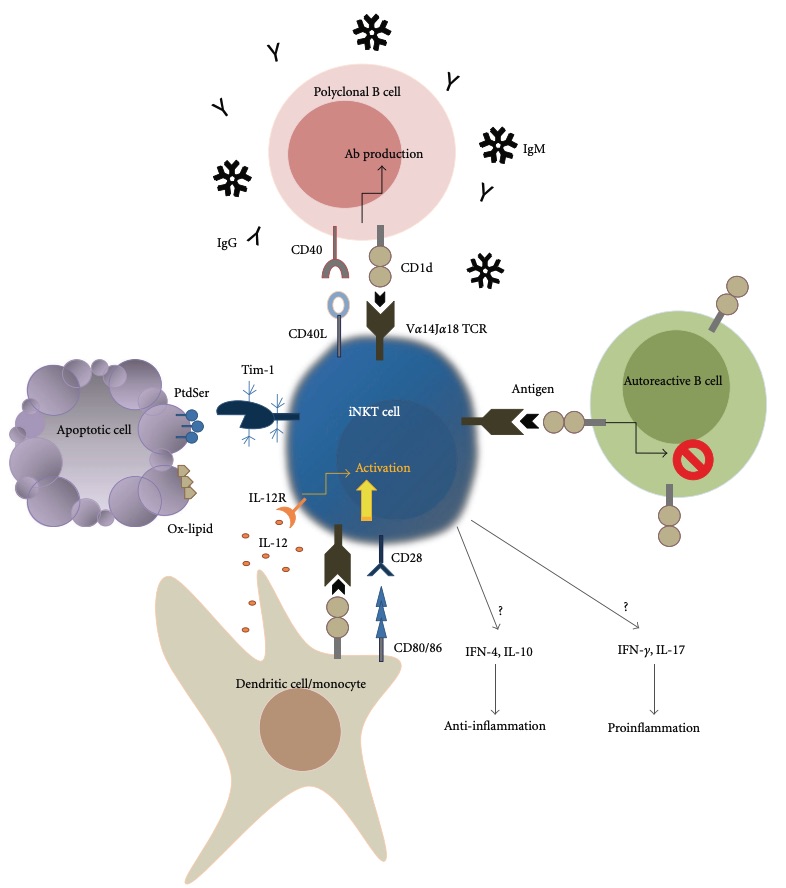Spontaneous Systemic Lupus Erythematosus (SLE) Mouse Model
Introduction of Systemic Lupus Erythematosus
Systemic lupus erythematosus (SLE), also known simply as lupus, is an autoimmune disorder characterized by high levels of autoantibody production and multi-organ tissue damage, including skin, kidney, heart, lungs, and joints. The etiology of SLE is believed to involve environmental, hormonal, and genetic factors. The diagnosis of SLE in humans is based on a combination of symptoms and laboratory tests and is quite challenging because of its complexity. Clinically, SLE presents as a diverse and heterogeneous disease that follows an unpredictable yet unrelenting course involving flares and remissions. Typical clinical symptoms include combinations of renal disease, swollen joints, skin rash, hematologic disorders, respiratory, and neurologic dysfunction.
 Fig. 1 The function of iNKT cells in murine lupus models. 1
Fig. 1 The function of iNKT cells in murine lupus models. 1
Spontaneous Mouse Models of SLE
There are two main categories of mouse models of SLE: spontaneous and induced. Creative Biolabs offers a variety of spontaneous lupus models, such as (NZB x NZW) F1, MRL/MpJ-Faslpr (MRL-lpr) and BXSB/Yaa mice. They spontaneously develop systemic lupus erythematosus (SLE)-like syndromes with heterogeneity and complexity that characterize different aspects of human SLE. Compared to induced models of SLE in nonautoimmune mouse strains, genetically susceptible animals of SLE show severer organ damage. That's why spontaneous lupus models are often preferred for modeling of lupus-associated neuropsychiatric or other target organ disease.
- MRL/lpr Model of Lupus
MRL/lpr mice contain a mutation in the Fas gene. Without Fas-Fas ligand interactions, apoptosis of B and T lymphocytes does not occur, resulting in massive lymphoproliferation that contributes to the observed acceleration of disease. Consequently, they exhibit similar manifestations to human SLE including glomerulonephritis, vasculitis, splenomegaly, arthritis, and the production of anti-dsDNA antibodies.
- (NZB × NZW) F1 Model of Lupus
The NZB/w F1 model is the first murine model described for lupus nephritis, which consists of the F1 hybrid between New Zealand Black and New Zealand White (NZB/W) mice. They can develop lymphadenopathy, splenomegaly, and elevated serum antinuclear autoantibodies (ANA). Particularly, they develop renal lesions that are remarkably similar to the pathology described in human lupus.
- BXSB/Yaa Model of Lupus
Unlike most of the mouse models, where females are more susceptible to SLE disease, BXSB/Yaa mice develop a lupus-like syndrome that is earlier and much more severe in males than females.
Although very few murine models can adequately mimic human autoimmune diseases, the development of these models has highly contributed to our current understanding of the pathogenesis of SLE at the genetic, cellular, molecular and environmental levels. Furthermore, they have proven to be powerful tools to evaluate novel treatment strategies.
Creative Biolabs provides assessments including but not limited to:
- Facial Lesions
- Cytokines Measurements
- Anti-DNA Antibody Measurements (ELISA & WB)
- Histological Examination
- Assessment of Nephritis
- Assessment of Lymphoproliferation
Meanwhile, in order to meet our customers' specific requirements and their various research objectives, Creative Biolabs also offers other rodent inflammatory & immunological disease models listed as follows that you may be interested in:
- Carrageenan Air Pouch Model
- Carrageenan-Induced Paw Edema Model
- Imiquimod (IMQ)-Induced Psoriasis Rodent Model
- Chemical-Induced Rodent Contact Hypersensitivity Model
- Passive Cutaneous Anaphylaxis (PCA) Model
- Delayed Type Hypersensitivity (DTH) Rodent Model
- Adjuvant-Induced Arthritis (AIA) Rodent Model
- Collagen-Induced Arthritis (CIA) Rodent Model
- Collagen Antibody-Induced Arthritis (CAIA) Model
- Cecum Ligation and Puncture (CLP)-Induced Sepsis Model
- LPS-Induced Rodent Sepsis Model
- Induced Models of Systemic Lupus Erythematosus
If you are interested in any of these rodent disease models, please send us an inquiry or contact us directly. We are willing to share our cutting-edge technologies and sufficient expertise with our clients to boost the impact of their brilliant studies.
Reference
- Chuang, Yi-Ping et al. "Modulatory function of invariant natural killer T cells in systemic lupus erythematosus." Clinical & developmental immunology vol. 2012 (2012): 478429. doi:10.1155/2012/478429.
For Research Use Only.
